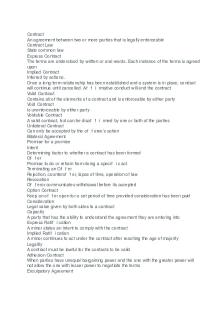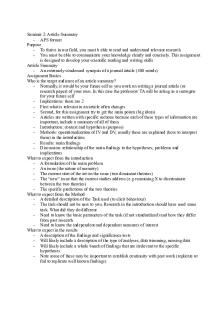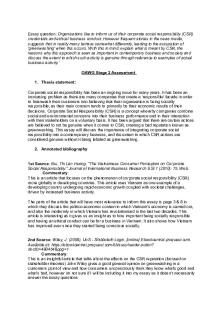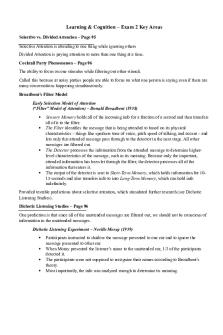2 Sources - Lecture notes 2 PDF

| Title | 2 Sources - Lecture notes 2 |
|---|---|
| Course | Public International Law |
| Institution | Durham University |
| Pages | 4 |
| File Size | 103.7 KB |
| File Type | |
| Total Downloads | 776 |
| Total Views | 886 |
Summary
Introduction ● Looking at rules and principles by which international law is made and where to find them ● Hart’s distinction between primary and secondary rules ○ Primary rules - rights and obligations (to do/not to do something) ○ Secondary rules → why primary rules are rules in the first place → ...
Description
Introduction ● Looking at rules and principles by which international law is made and where to find them ● Hart’s distinction between primary and secondary rules ○ Primary rules - rights and obligations (to do/not to do something) ○ Secondary rules → why primary rules are rules in the first place → enables us to identify the primary rules, conditions of existence of the primary rules = sources ● Legal positivism - Hart ○ Distinction between law and morality ○ No need for morality when creating/defining laws → enacted by legitimate authority and are
accepted by the society as such ○
● ●
Sources are crucial to the objectivity and legitimacy of international law → he criticized international law for lacking precise secondary rules Starting point for sources of international law (lists the sources) → Art. 38 (1) of the Statute of the ICJ International conventions (treaties) and custom are the most important
Treaties (International Conventions) ● Vienna Convention on the Law of Treaties (VCLT) - Art.2 defines a treaty ● General rule - states are bound by the international agreements which they have “signed up to” or consented → must be performed in good faith ● All parties to the treaty are bound by its provisions → legal obligations ● Bilateral treaty - narrow scope “contracts” between two parties ● Multilateral treaty - broad scope “legislation” between more than two parties ○ Sets up an entire regime → ex. ECHR ● Treaty contract - creates obligations for the states concerned ● Law-making treaty - use treaties to ‘create’ law ○ Distinguish this from treaty contract by looking at the purpose and aim of the treaty ● Treaty may develop customary international law → give rise to a new rule of customary international law ● Treaty may crystallize a developing rule of customary international law ○ For sure accepted as custom ● Treaty may codify existing customary international law ○ Bind parties to the treaty as a matter of law ○ Bind non-parties as a matter of custom Customary International Law ● Legal rule/obligation stems from a common and repeated practice → shown to exist, becomes binding ● Customary international law emanates from the will of States → cannot be bound unless it has given its consent ● “Not only must be acts concerned amount to a settled practice, but they must also be such, or be carried out in such a way, as to be evidence of a belief that this practice is rendered obligatory by the existence of a rule of law requiring it.” - North Sea Continental Shelf ● Two elements that need to be satisfied: ○ State practice (objective) ○ Opinio juris (subjective) (1) State Practice ● What states actually do and say (objective) ● Generality of the practice: practice must be common to a wide number of states
●
Anglo-Norwegian Fisheries ○ Dispute over a body of water → Norwegian waters or high seas, ie UK can fish ○ Norway's claims to the waters were consistent with international laws concerning the ownership of local sea space ○ Emphasized action rather than statements ● However, Harris deems statements for/against a legal position has been relevant evidence of state practice ● Asylum case ○ Rebellion leader granted asylum in Colombia, but Peru refused to grant safe passage there ○ uncertainty and contradiction to diplomatic asylum → Colombia was unable to prove the existence of this custom ○ Custom requires: “Constant and uniform usage, accepted as law” ● However, Harris deems that corresponding practice does not have to be absolute rigorous conformity ○ In order to deduce the existence of customary rules, the Court deems it sufficient that the conduct of States should, in general, be consistent with such rules, and that instances of States conduct inconsistent with a given rule should generally have been treated as breaches of that rule, not as indications of the recognition of a new rule ● North Sea Continental Shelf cases ○ Sorting of boundaries of the continental shelf, rich in oil and gas ○ Equidistance principle in Geneva Convention, Germany would have had a smaller portion → Germany was granted more shelf ○ Germany had not ratified the Geneva Convention, but was Article 6 a norm-creating provision which is accepted as customary international law and would bind non-parties? ■ Equidistance was a secondary obligation after the primary obligation to effect delimitation by agreement ■ Not jus cogens and “Boundary line justified by special circumstances” Art 6 demonstrates express provision → doubt that this section had “norm creating character” especially if compared to Art 1 or 2 ■ Equidistance was not crystallised → not an obligatory method ○ Duration of the practice will vary according to the subject matter → “short period of time is not necessarily a bar” → possibility of ‘instant custom’ ■ “Extensively and virtually uniform” → general recognition of a legal obligation ○ Recognition of “States whose interests are specially affected” → not necessarily equal weight given to the practice of States, some may carry more influence (2) Opinio Juris ● Belief of a State that the practice was taken as a legal obligation (subjective) ● Sense of legal duty, state practice may be evidence of opinio juris (Shelf) ● Nuclear Weapons Advisory Opinion ○ UN asked the ICJ if nuclear weapons were permitted under international law ○ no source of law, customary or treaty, that explicitly prohibits the possession or even use of nuclear weapons ○ Opinio juris differs between States, therefore there is no set opinio juris… Persistent Objector ● A State that persistently objects to the formation of a rule of custom from the beginning will not be bound by that rule when it develops ● Anglo-Norwegian Fisheries ○ Norway has consistently opposed any attempt to apply a closing rule for bays Regional Custom
●
Is it possible to have a customary international law rule applying within a region only? → Asylum case recognized the possibility of local/regional customs (states of Latin America recognize the right of embassies to offer political asylum) but that did not occur in the Asylum case ○ Failed to prove consistent and uniform usage of the alleged regional custom by the relevant States (fluctuations and contradictions) Changing Customary International Law ● Change by breaking it, however until it is recognized that the existing rule has lapsed and a new one is formed, States are acting in breach ● Courts attempt to define when the law “changes” ○ Jurisdictional Immunities case ■ Decisions of Italian courts denying Germany state immunity seen as breaches Relationship Between Customary International Law and Treaty Law ● Complementary → possible for a rule to be in both ● If they conflict, treaty law will prevail ● Customary rule arises after the treaty, position is unclear but practically, the ICJ will try to adopt a complementary interpretation of the customary rule so there is no conflict ● Non-parties to the treaty are still subject to the customary law rule “jus cogens” ● The Nicaragua case ○ US supported rebellions against Nicaraguan government ○ customary laws exist alongside treaty laws ■ However even if customary laws are incorporated as treaty laws, doesn’t mean that the customary laws no longer exist → relevant to US reservation on treaty ○ Violated the customary law not to use force against another State and not to interfere in affairs ○ Jus cogens (“compelling law”) - fundamental principles from which no derogation is permitted ● Are jus cogens customs the same as treaties? → both binding? General Principles of Law ● Legal principles that exist outside of international law and are common in municipal law → “recognized” by States ● Difficult to define and apply ● Rules underlying international legal relations to prevent gaps in the law Judicial Decisions and “the teachings of the most highly qualified publicists” Judicial Decisions ● Uncertain to what extent judicial decisions are just “declaratory” ● All international courts and tribunals and domestic judicial decisions ● No doctrine of binding precedent in international law ● Orders of the ICJ have no effect other than on the parties to the dispute and for that matter ● Appellate jurisdiction in some courts, but no overall ‘high court’ to deal with appeals from all international tribunals Academic Writings ● Subsidiary sources that cannot create law but offer guidance Other Sources / ‘Soft Law’ ● “It is inconceivable that modern treaty regimes or International organizations could function successfully without resort to soft law” - Boyle ○ Responsibility 2 Protect (R2P) doctrine → endorsed at the 2005 UN World Summit
●
●
● ●
●
Non-legally binding but normatively worded instruments ○ Easier to implement (assists in the development and application of international law, eg. customary international law) ○ Doesn’t place a tight constraint → flexible Resolutions of UN treaty bodies ○ Not binding, but guiding ■ some may be binding on members → ex. UNSC ○ General comments are interpretations of treaty provisions ○ interplay between these declarations/resolutions and the formation of customary international law Jus cogens Draft articles of the International Law Commission (ILC) ○ Expert body (well respected international lawyers) established by UNGA issuing half codified new international rules that may work as catalysts for these rules to be accepted ○ Ex. VCLT International Committee of the Red Cross (ICRC) ○ Expert organization promoting and implementing laws of war ○ Ex. Geneva Convention → prisoners who have a protective status...
Similar Free PDFs

2 Sources - Lecture notes 2
- 4 Pages

2 - Lecture notes 2
- 5 Pages

Lecture notes, lecture 2
- 3 Pages

2 Biodiversity - Lecture notes 2
- 33 Pages

Chapter 2 - Lecture notes 2
- 30 Pages

Blaw 2 - Lecture notes 2
- 4 Pages

Chapter 2 - Lecture notes 2
- 4 Pages

Seminar 2 - Lecture notes 2
- 2 Pages

Stage 2 - Lecture notes 2
- 3 Pages

Micro 2 - Lecture notes 2
- 18 Pages

Prof 2 - Lecture notes 2
- 3 Pages

Mast200 2 - Lecture notes 2
- 3 Pages

Quiz-2 - Lecture notes 2
- 7 Pages

Chapter 2 - Lecture notes 2
- 11 Pages

Chapter 2 - Lecture notes 2
- 4 Pages

Exam 2 - Lecture notes 2
- 5 Pages
Popular Institutions
- Tinajero National High School - Annex
- Politeknik Caltex Riau
- Yokohama City University
- SGT University
- University of Al-Qadisiyah
- Divine Word College of Vigan
- Techniek College Rotterdam
- Universidade de Santiago
- Universiti Teknologi MARA Cawangan Johor Kampus Pasir Gudang
- Poltekkes Kemenkes Yogyakarta
- Baguio City National High School
- Colegio san marcos
- preparatoria uno
- Centro de Bachillerato Tecnológico Industrial y de Servicios No. 107
- Dalian Maritime University
- Quang Trung Secondary School
- Colegio Tecnológico en Informática
- Corporación Regional de Educación Superior
- Grupo CEDVA
- Dar Al Uloom University
- Centro de Estudios Preuniversitarios de la Universidad Nacional de Ingeniería
- 上智大学
- Aakash International School, Nuna Majara
- San Felipe Neri Catholic School
- Kang Chiao International School - New Taipei City
- Misamis Occidental National High School
- Institución Educativa Escuela Normal Juan Ladrilleros
- Kolehiyo ng Pantukan
- Batanes State College
- Instituto Continental
- Sekolah Menengah Kejuruan Kesehatan Kaltara (Tarakan)
- Colegio de La Inmaculada Concepcion - Cebu